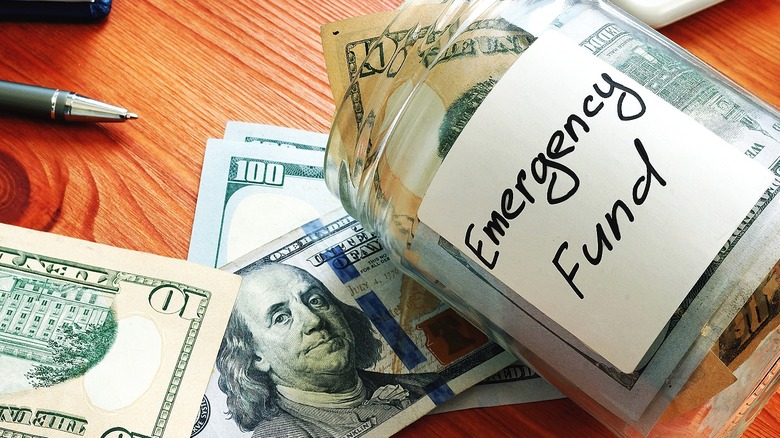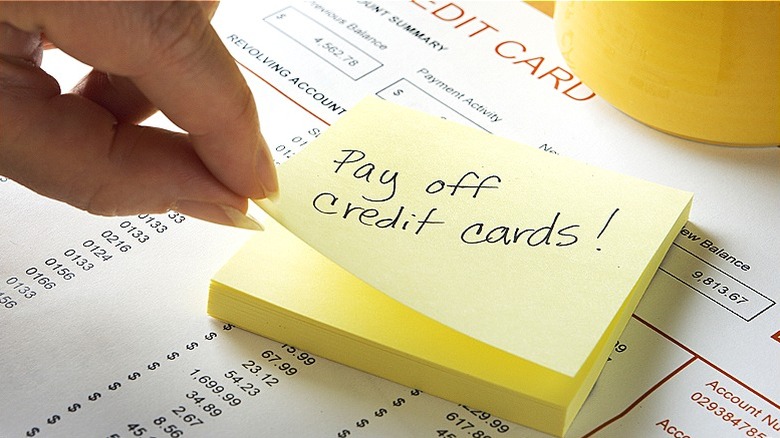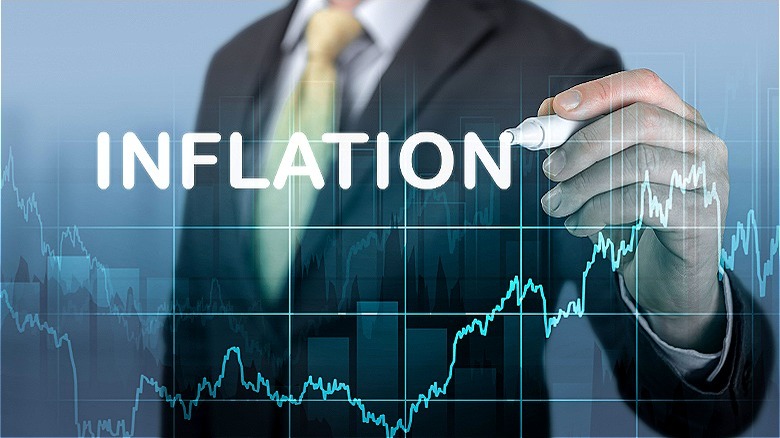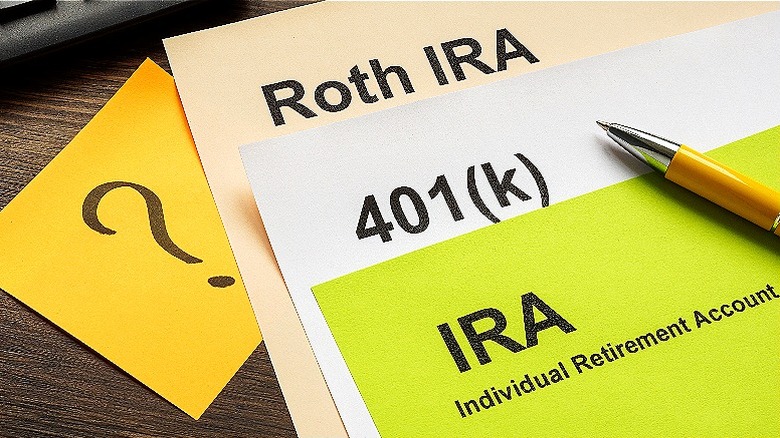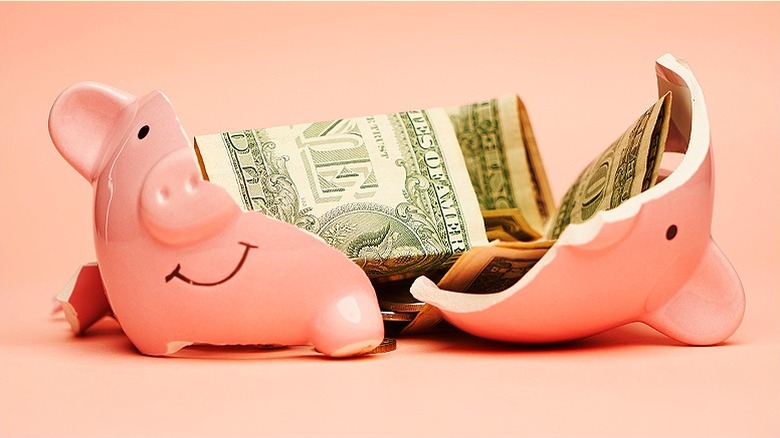The Sneaky Reason An Emergency Fund Could Be Your Downfall
During the COVID-19 pandemic, savings accounts hit record levels in the United States. U.S. consumers received multiple rounds of stimulus checks at the same time shutdowns prevented them from actually spending the dough. Since then, savings levels have returned to normal. According to NerdWallet's 2023 consumer savings report, 45% of Americans can cover a $1,000 emergency expense without needing to borrow money.
It's important to save for unexpected life events. Failure to do so could find you at the mercy of predatory personal loans, taking on debt from high-interest-rate credit cards, or dipping into your retirement account — all serious financial faux pas. And that's where an emergency fund comes in, which the Consumer Financial Protection Bureau defines as "a cash reserve that's specifically set aside for unplanned expenses or financial emergencies." Some examples would include job loss, unexpected medical bills, and home or car repairs.
In the past, it was common to put away six months' worth of living expenses in an emergency fund. With the high cost of living nowadays, it can be a challenge to save that much, but at a minimum, try to save up at least three months' worth. Typically, living expenses include housing, food, health care, and making at least minimum payments on your existing debts. Most personal finance experts agree that growing an emergency fund is a prudent, wise financial decision, but there are a few caveats to watch for.
Not paying off expensive debt first
Consumers with a significant amount of high-interest debt may want to concentrate on paying down those pricey loans first before focusing on savings. Carrying a balance on a credit card, payday loans, or rent-to-own agreements can often carry interest rates of more than 20%. That will literally cost you thousands of dollars extra over the life of the loan.
The whole point of having an emergency fund is to avoid expensive debt if an unexpected situation arrives, but if you already have loads of pricey debt, then you might as well pay it off before you start saving. In a worst-case scenario, you can always turn back to those high-interest-rate funding sources. But if a significant emergency never happens, you'll be in a much better place financially for having paid down debt with exorbitant rates.
On the other hand, certain types of "good debt" can be paid more gradually as you simultaneously build an emergency fund. Good debt includes mortgage payments, car loans, student loans, and a few others. Regardless of good debt or bad debt, never miss/skip debt payments for the sake of growing your emergency fund. Always make at least the minimum payment on time to avoid late fees or negative marks on your credit report.
The yield may lag inflation and other investments
By the very nature of an emergency fund, quick access to your money is required, defined in the financial world as being liquid. That is, you can withdraw money easily at any time. You'll also want to protect the value of the emergency fund from losses, like stock market downturns. For those reasons, emergency funds are typically invested in savings accounts.
Until recently, savings accounts were a boring and low-yield investment, but the Federal Reserve's fight against inflation has resulted in interest rates that actually make a savings account worthwhile. Nowadays, the annual percentage yield (APY) for a savings account can exceed 4%, or 5% in some cases. For example, an emergency fund with a $10,000 balance in a 4.60% APY savings account would earn $469.82 in interest per year. Over longer periods of time, that balance will grow even faster due to the effects of compounding interest.
That said, savings account yields do fluctuate with ambient interest rates and what may pay 4.60% today may pay less in the future. In 2021, savers would have been lucky to receive an APY of 0.50% on their funds. That was well below the rate of inflation at the time, which means that the emergency fund would've been losing purchasing power each year. Similarly, the S&P 500 stock market index has returned an average of 10.13% per year since 1957. Accepting lower, risk-free yields is inherent to emergency funds, but that's also why you might want to limit the balance to three to six months' worth of expenses and invest excess savings elsewhere.
Not saving for retirement as well
When your monthly budget is tight, it can be tough to decide between building an emergency fund and planning for your golden years in retirement. The maximum contribution limits for both IRA and 410(k) retirement accounts jumped for 2024 — to $7,000 and $23,000 per year, respectively. While experts preach that contributing to a retirement account is no excuse for not saving in the present, the opposite holds true as well. Don't fixate on your goal of short-term savings at the total expense of saving for retirement. The best solution is a combination of both.
That's particularly true if your employer offers to match your contributions into a 401(k) or IRA account. What that means is that for every $1 you contribute to the retirement account from your paycheck, your employer will contribute $1 of its own. That's literally free money, but the generosity isn't unlimited. Employers set an upper limit on the matched amount, typically 3% to 6% of your salary each year.
If your employer offers this perk, take advantage and contribute at least enough to receive the full match benefit. Once that threshold is met, you can concentrate on bolstering your emergency fund if it's running low.
The temptation to spend the money on a non-emergency
You've worked hard and maybe even sacrificed by cutting back your spending on splurges, such as restaurant meals, to build an impressive emergency fund. Now, resist the urge to ransack those funds for non-critical expenses like a vacation or new clothes. To avoid temptation, be sure to deposit your emergency fund into a dedicated high-yield savings account. Don't commingle the funds with your everyday checking account — or it could be your downfall.
Especially don't keep an emergency fund in literal cash under the mattress or in a sock drawer. Not only will the temptation to borrow a few dollars from the fund be stronger, but the balance won't be earning any interest, which can really add up at today's higher rates. Building up what old-timers used to call a "rainy day" fund for life's surprises is definitely an admirable goal. Just don't do so at the expense of neglecting high-interest debt payments or failing to invest anything for retirement.
